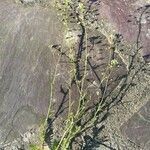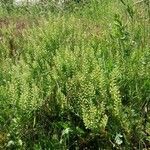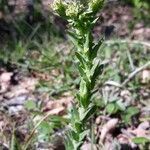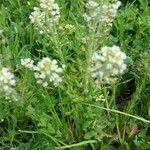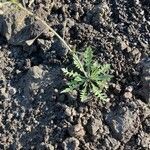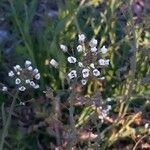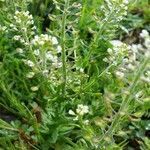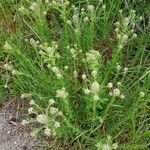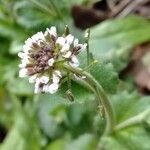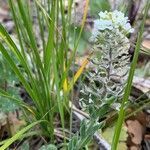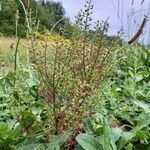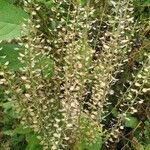Annuals; densely hirsute. Stems simple from base, erect, unbranched or branched distally, (0.8-)1.2-5(-6.3) dm. Basal leaves rosulate; petiole (0.5-) 1.5-6 cm; blade oblanceolate or oblong, (1-)2-6(-8) cm × 5-15 mm, margins entire, lyrate, or pinnatifid. Cauline leaves sessile; oblong, lanceolate, or narrowly deltate-lanceolate, (0.7-)1-4(-6.5) cm × (2-)5-10(-15) mm, base sagittate or auriculate, margins dentate or subentire. Racemes much-elongated in fruit; rachis hirsute, trichomes spreading, straight. Fruiting pedicels horizontal, straight or slightly recurved, (terete), (3-)4-8(-10) × 0.3-0.4 mm, hirsute. Flowers: sepals oblong, (1-)1.3-1.8 × 0.6-0.8 mm; petals white, spatulate, (1.5-)1.8-2.5(-3) × (0.2-)0.5-0.7 mm, claw 0.6-1 mm; stamens 6; filaments (1.2-)1.5-1.8(-2) mm, (glabrous); anthers 0.3-0.5 mm. Fruits broadly oblong to ovate, (4-)5-6(-6.5) × (3-)4-5 mm, (curved adaxially), apically broadly winged, apical notch (0.2-)0.4-0.6 mm deep; valves thin, papillate except for wing, not veined; style 0.2-0.5(-0.7) mm, slightly exserted beyond, or included in, apical notch. Seeds (dark brown), ovoid, 2-2.3(-2.8) × 1-1.4 mm. 2n = 16.
Annual or biennial. Stem erect, branched above, hairy, (10)-20-45 cm tall. Lvs hairy. Basal lvs mostly withering before fls open, narrow oblanceolate, lyrate-pinnatifid, rarely entire, c. 3-5 × 0.5-1 cm; petiole < or = lamina. Stem lvs suberect, narrowly triangular, sessile, 10-30-(60) × 2-10 mm, with narrow pointed amplexicaul basal lobes; margin with short coarse teeth or entire. Racemes (5)-10-15 cm long; rachis densely hairy; pedicels densely hairy, spreading, 4-6 mm long at fruiting. Sepals glabrous or hairy, c. 1 × 0.5 mm. Petals white, clawed, 1.5-2 × c. 1 mm. Stamens 6. Silicle oblong, notched, 5-6 × c. 4 mm; lower part of style connate with the broad wing, upper part free for c. 0.5 mm, not or slightly protruding from the short apical notch; valves covered with small scale-like papillae. Seeds very dark brown, ovoid, 2-2.5 mm long.
Annual or biennial herb; stems erect, 20–60 cm high, clothed with dense, spreading, simple, acicular hairs. Basal leaves ovate to obovate, entire to dentate or slightly lobed, to 7 cm long, sessile or petiolate, non-persistent; cauline leaves narrowly triangular, entire to dentate, auriculate, sessile, pubescent. Inflorescence an elongating raceme. Sepals 15 mm long, spreading, glabrous. Petals 2–2.5 mm long, clawed, white. Stamens 6. Style c. 0.5 mm long, included to exserted. Silicula dehiscent, broadly ovate, 5–6 mm long, c. 4 mm wide, the valves covered with vescicles which are scale-like when dry; wings ⅓–¼ fruit length; pedicels 5–6 mm long, horizontal, pubescent. Seeds 2–2.5 mm long, ovate; radicle incumbent.
A cabbage family herb. It can grow for one or two years. It grows to 60 cm high. It has a well developed taproot. The stems branch about half way up. The stem is solid and round in cross section. The leaves are slightly hairy. They have teeth along the edge. The leaves at the base form a ring. They are slightly lobed. Leaves on the lower stem narrow to a stalk. Those higher up are small and triangle shaped and do not have leaf stalks but clasp the stem. The leaves on the stem are 5-10 cm long. The flowers are small and white. The fruit are broadly oval. They have wings at the ends. There is also a notch at the tip.
Densely short-hairy annual or biennial 2–5 dm; basal lvs elongate, oblanceolate, entire to shallowly lobed; cauline lvs erect or ascending, lanceolate to narrowly oblong, 2–4 cm, entire or denticulate, sessile, clasping by acute auricles; racemes dense, to 15 cm, the mature pedicels divergent, 4–8 mm; pet white, 2–2.5 mm; stamens 6; anthers yellow; frs oblong-ovate, 5–6 mm, broadly winged above, the short style barely or scarcely exsert; 2n=16. Native of Europe, established as a weed of fields, roadsides, and waste places through our range and westward. May, June.
